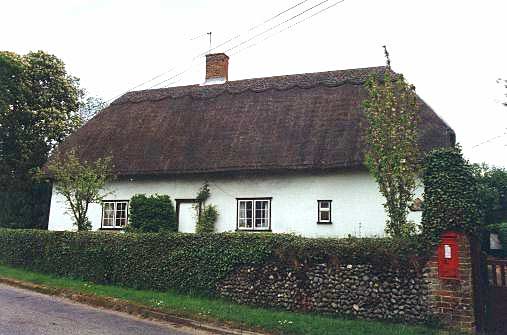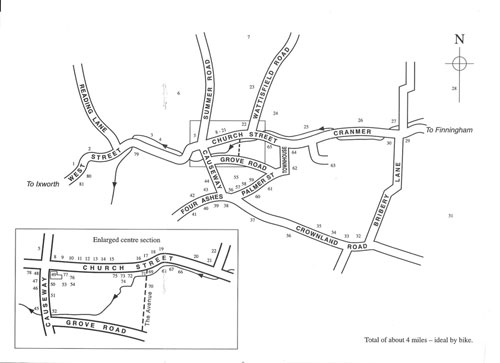Historic Trail
The trail begins and ends at the west end of the parish approaching from Ixworth. There is, of course, no right of entry to private property. A few houses are barely visible from the road but have been included for general interest. The village comprises a central street near the church plus hamlets on the outskirts. Parking at the Memorial Hall is recommended whilst looking round the village centre.
This walk is about 4 miles. download pdf guide (50 pages!)
Other walks: Hartshall Lane | Hundred Lane | Orchid | Three Windmills | Trades & Occupations
Enlarged central section of the map
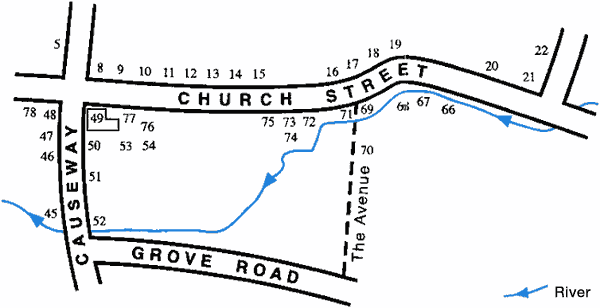
The fertile boulder clay of this part of Suffolk has determined Walsham’s reliance on agriculture for its economy. Before the Black Death of 1349, every available piece of land was cultivated for food but, with the drastic reduction in the population in that year, tenants started to enclose their fields for dairy herds. Spinning and weaving of wool, hemp and linen have occupied local people through the ages together with thatching, brewing, smithing etc. The first maps drawn in the early 19th century show a landscape of small arable fields and pasture. Since World War II most fields have been enlarged for ease of cultivation with large machinery.
Walsham le Willows retains sixty-two pre-1700 timber-framed houses that were all part of the property of the lord of the manor, some ‘free’, some ‘unfree’. In the medieval period villeins, or unfree tenants, paid rent that comprised cash, hens, eggs and a duty to carry out varied works including ploughing, harvesting and spreading manure on the lord’s land. Whenever unfree property changed hands, it was ‘surrendered’ at a manor court where the incoming tenant paid a fee to the lord.
The proceedings of each court were recorded on rolls of parchment, many of which survive, and are kept in the Suffolk Record Office at Bury St. Edmunds. It is mainly by reference to these rolls that it is possible to build up a history of tenancy. Free tenants were not totally free but paid less rent and had more freedom to dispose of property that was not recorded at court, making it more difficult to trace the history. Tenements were often named after an early tenant, usually one of the 15th century, and the names persisted even though a new house might be rebuilt on the same site.
Of the surviving houses, usually known as messuages or tenements, many retain small sections of early carpentry although considerably added to in later centuries. One house is late 14th century, thirteen are 15th century, thirty are 16th century and eighteen are 17th century. Pre-1500 tenements were usually built with a hall that was open to the roof and contained a hearth with a fire on the floor. At one end of the hall was a cross-passage leading from the front to the back door. Two service rooms, a buttery and a pantry, led from the passage. At the other end of the hall was a raised platform where the head of the house sat for meals and adjoining this high end of the hall was usually the parlour. The parlour and service rooms had upper rooms, often used for storage.
1. West Street Farmhouse
A late 16th century former farmhouse with a rebuilt chimney stack. John Parker was the tenant in 1577 when he died surrendering the house and 13½ acres of land to his wife until his sons were 26 years old. He also held the Chestnuts (19), which his eldest son John inherited. Both houses were called Jayes. His younger son, Thomas, was admitted in 1590 to West Street Farm so he probably built the present house. Thomas died in 1632 and his son Richard was admitted. Richard took advantage of the economic boom in agriculture, acquired more land in Walsham, Stanton, Bardwell and Redgrave and called himself a gentleman. In his will he gave £20 for the churchwardens to buy land, the rent of which was to go to the poor. He, himself, was a churchwarden.
2. West Cottage
Called Ebells tenement, this cottage was built c. 1450 by William Ebell. Always a typical peasant’s home with just 3 acres of land, insufficient to sustain a medieval family, William would have had to earn money as well. Its roof space still retains some smoke-blackened thatch from its open fire. In 1482 Adam Ebell was ordered to repair the house which had been in a dilapidated state for ten years.
A 1537 rental shows it was then held by Geoffrey Lyneham and in 1555 Walter Martin, who lived at Church Farm (46) left ‘my house called Lynamys’ to his younger son John. By 1577 John’s brother Nicholas held the house still with its 3 acres and a chalk pit. The Martin family continued as tenants until 1626 from which time it changed hands fairly frequently. The barn was first mentioned in 1581.
3. Brook Farm Cottages
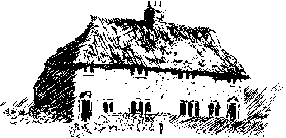
Built c. 1620 when Richard Neale was admitted to ‘a newly built tenement called Cooks.’ He paid tithes on an ‘ortchard and one mowing, in his yard 3d, hempe’.
The previous house on the site was part of the property held by Thomas Flatman of what is now The Lawn (79). Soon after it was made into two cottages and then reverted to the tenancy of the resident of The Lawn who, by then, was John Page.
4. Brook Farm
Named Scotts tenement after an earlier tenant Stephen Scott. In the late 16th century John Margery was ordered to explain whether his tenement Scotts was free or copyhold; he must have won the argument because it is referred to as ‘free’ in later documents.
In his will of 1588 he left the house to his son John. His wife was to have the parlour for her dwelling and have firewood laid at her door. His inventory included possessions valued at £38 2s 6d. in a hall, parlour, hall chamber, parlour chamber, old and little butteries, a dairy house, a back-house and a barn.
He also held two other houses near the church, which have not survived. Either he, or his son John built the present house as it dates from the late 16th century. It stayed in the Margery family until 1673 when it was acquired by John Purcas, a grocer from Bury St. Edmunds.
About 50 metres from the crossroads, on the left of Summer Road, once stood an Elizabethan theatre ‘in the round’. Nothing remains.
5. Hall House
This house dates from the late 17th century. Its name reveals its history. It is on the site of the medieval manor house known as Walsham Hall that stood on Hall Green. The manor site was known to contain a hall, garret, knights’ chamber, bailiff’s room, long-house, dovecote, sheepcote, barn and numerous other farm buildings. Edmund Page was the first tenant of the one acre site with the house which became known as Pages. John Freeman who was admitted in 1689 probably built the present house.
6. Sandpits Farm
Built in the early 17th century, very little is known of the occupants because, although the name Sandpits Field occurs in surveys, there is no mention of a house. In 1694 Ann Seaman, a widow, surrendered the land which adjoins the house to a carpenter Nathaniel Rodwell who, at that time, was living at 2, Vine Cottage (20).
Is it possible that the house was moved from elsewhere and rebuilt on the present site? The initials JM are inscribed on the fireplace lintel. By 1817 the owner/occupier was Ann Miller who owned several properties; it was then described as a farmhouse with an office, yard and garden.
Note: this property is at the end of a private lane and is not visible from the road.
7. Fishponds Farm
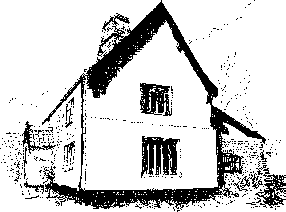
Fishponds Farm So called because the grounds contain a large pond presumed to be the fishpond of the manor. The surrounding field has been known as Fishpond Field since at least 1336. The surveys of the parish do not show a house; they mention a ‘hayhouse’ but Fishpond Farm is not a barn conversion. Could it, also, have come from elsewhere and been re-erected on this site?
It is dated late 16th century. The kitchen contains a crenellated beam that may have been the dais of the open hall of a previous house. In 1661 Thomas Rainbird surrendered 11 acres of land and pasture with a messuage ‘now built upon it’ to Robert Hagtree. Robert acquired The Rookery (24) in the following year, paid others to work his land and became a gentleman. The illustration shows the diamond mullion windows at the rear of the house.
Note: this property is at the end of a private drive.
8. Six Bells Inn
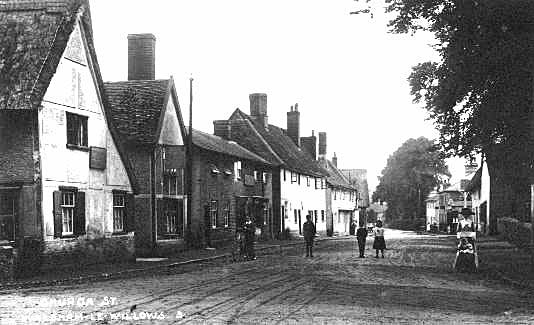
Although a former house on this site, known as Fullers, was used to bake bread and brew ale (the staple medieval diet) it first became a public house in c. 1844 with William Day as the beer-seller.
The present building was said to be ‘newly built’ in 1523 and occupied by William Vincent. His son Stephen died in 1549 leaving his son John his mercers shop and candle making equipment. The house, at this time, was jettied along two sides (evidence of which can be seen inside) with shop windows.
A later Stephen Vincent had a grocers shop here. His wife Elizabeth spun and wove flax and hemp here and, after Stephen’s death, married Samuel Canham from Crownland Hall (36). It was first called the Six Bells (after the bells in the church tower) in the 1861 census. In the 15th century John Ringbell lived here.
9. The Guildhall

Now a row of three cottages, this building was erected by religious guilds c. 1500. There were three guilds in Walsham – Holy Trinity, St. John the Baptist and St. Katherine.
The first floor of the building was unpartitioned, open to the beautiful timber roof and would have been used for meetings, feasts and as a base for processions to church. After the Reformation it was acquired by the village charities and eventually became a workhouse.
An inventory for 1783 lists twenty-nine spinning wheels used by unsupported women and children for spinning hemp to make sacking. Amongst the furniture were children’s chairs and wooden cradles. One room was set aside as a ‘lying-in chamber’. Notice the genuine early 18th century Royal Exchange Association fire insurance sign.
10. The Cottage
The cottage, which was built in the gap between the guildhall and the next house, is difficult to date, being made of reused timber. It was once a cycle shop.
11. The Dages
Known as Coggeshalls, the earlier house on the site was built in 1389 by John Coggeshall who was the cook at the manor.
In 1428 John Page, a mason, became the tenant. (the name Dages may originate from a misreading of deeds; the house next door was known as Dayes).
The present house was built in the 16th century probably by Thomas Smith, a gentleman who held other houses in Walsham, Stanton and Norfolk. When he died in 1603 he left the house to his son William but by 1607 Richard Rainbird became the tenant. Richard was the fifth wealthiest man in the parish in 1625 when he paid tithes on seventeen cows, three bulls, ten calves, geese, orchard, meadow, pasture and hempland. His widow Elizabeth lived in the house for forty-six years.
It was then held by John Hunt esq. (whose memorial is inside the church) together with other houses and lots of land. By the 19th century it was the home of a blacksmith and wheelwright and for most of the last century was the home and workplace of Landymores the tailors.
12. Yew Tree Cottage
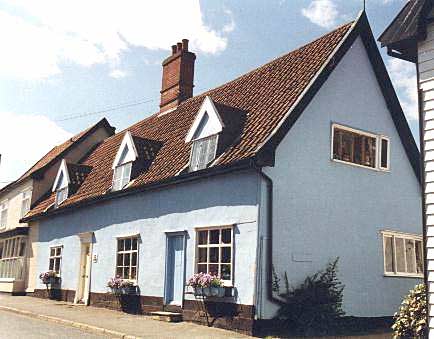
Called Deyes after its 15th century tenant Richard Deye who made his will in 1489 before going on a pilgrimage ‘over the sea’. He left money for seating in the church, the tools of his coopering trade and a brass pan of 24 gallons to the guilds, no doubt to help with the catering on feast days.
The Reeve family were the occupants during the 16th century and the Rainbirds for most of the 17th. The present house was built c. 1620. An inventory of 1662 lists goods in the hall, hall chamber, kitchen, kitchen chamber and dairy – a typical two-up two-down cottage. The dairy contained cheese, six cows, a calf and hemp.
13. The Tiled House
The rear part of this house dates from c. 1500; the extension at the front was added c. 1620.
One of the first occupants was John Taylor but in 1548 William Vincent, a tailor, acquired it. The house was known as Taylors. William was the brother of Augustine who lived at 2, Vine Cottages (20).
There is a crown post in the early part of the house but it was not built as an open hall.
14. Willow Cottage
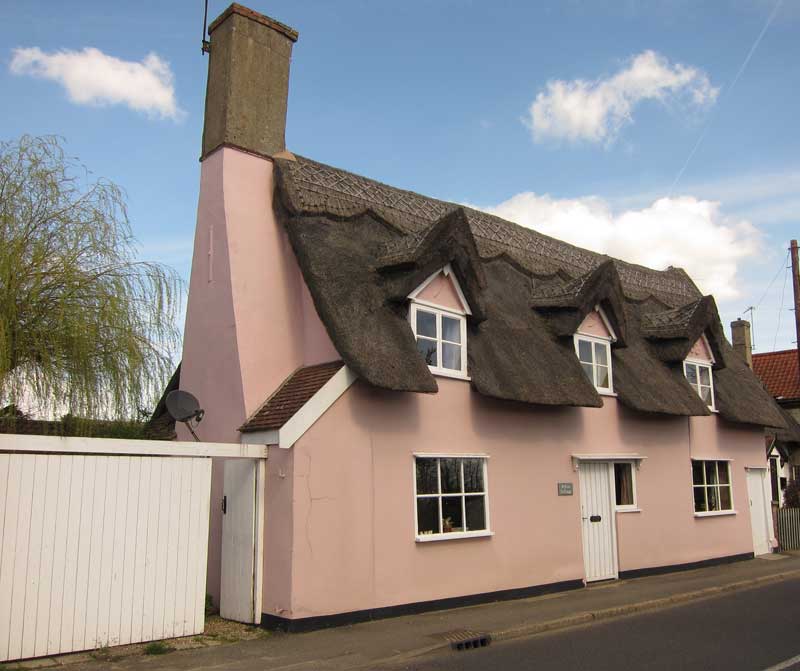
1753, which is written in raised plaster across the front, is the date of the earliest surviving deed but the cottage was built on the land of John Rainbird, who was left the Tiled House by his mother in 1662.
In 1673 he surrendered it to William and Susan Peck. It was at the centre of a very busy village in the 19th century and the deeds show it occupied by a succession of tradesmen – a wool-comber, carpenter, butcher, shoe-maker, blacksmith, collar and harness maker and watch maker.
15. The White House
This is one of the earliest buildings in Walsham although only fragments of the original house are visible. Its first tenant was Robert Lister who was a prominent character in the village being bailiff of the manor for several years.
Dated late 15th century and called Listers, from 1559 until at least 1695 it was held by the Clarke family. Richard Clarke, who died in 1638, was a husbandman, a small farmer. His son Richard died in 1689 describing himself as a yeoman. His inventory lists possessions in a hall, hall chamber, closet, corn chamber, back house, dairy, cheese chamber, barn, stable and cowshed. He owned seven cows, four bullocks, twelve sheep and a mare.
16. The Old Infants’ School
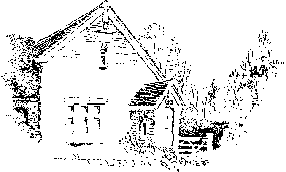
The Infants’ School was built by the Martineau family and opened in 1872. It provided a place of safety if not enjoyment for the large numbers of children whose mothers needed to work. Many three-year-olds were amongst the scholars.
17. Sideways
Another early building dated between 1450 and 1510 with a new parlour at the front of the house. As a free tenement little is known of its earliest occupants.
It was called Myllons in the 1577 survey probably after Robert Mollons a 15th century tenant. By 1695 it was held by Edward Crispe, a grocer from Bury St. Edmunds, who rented out several properties in the parish. It served the village as a garage until quite recently.
18. The Congregational Church
The Classical façade and Greek Doric porch make this building unmistakable. It was built in 1844 by the Wesleyans at a time when there was also a Baptist and an Independent Chapel in the village.
19. The Chestnuts
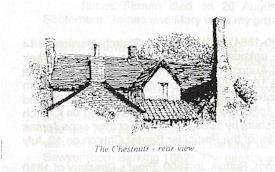
Also a free tenement known as Jayes after William Jay a 15th century tenant, it belonged to the Prior of Bricett who received ½lb. of cumin pa. from the manor as rent.
John Parker held it during the next century. In 1845 William Freeman, a surgeon lived there and in 1912 it was the home of Isaac Clarke.
20. 2 Vine Cottages
This cottage was built in the 15th century with an open hall. The earliest reference to a house on the site is in 1505 when Walter Reeve surrendered a messuage and a small pightle to William Vincent. His son William died in 1557 leaving his daughter Maude his feather bed, lots of household utensils and his wife’s best beads. His wife Alice had died in 1543. Maude also inherited a pair a shears, a spinning wheel and a reel. One of his sons was William Vincent the tailor who lived at the Tiled House (13). Another son Augustine, a woollen weaver inherited the house and, in his will of 1598, he left looms and slays to his stepson.
21. Maltings House
Built for John Miller, the owner of the maltings, the house reflects his prosperity. Notice the pilasters between the windows and on the corners. The same feature is repeated on the maltings just round the corner in Wattisfield Road.
22. The Maltings
Built between 1817 and 1844 and operating as a maltings and brewery, the maltings were converted into dwellings in 1979.
23. The Mill House
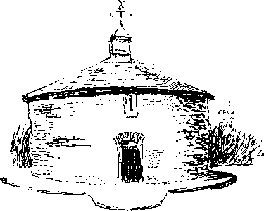
A squat round brick building topped with a tiled roof and a central chimney with a weather symbol at the top of it.
The round base is all that remains of a post-mill which operated from at least 1817. There were two medieval and two later mills in Walsham.
24. The Rookery
The house on this site was the home of the Hawes family probably from 1283. It was one of the largest holdings in Walsham with a messuage and 40 acres of land. Several of the Hawes family died in the Black Death of 1349 but enough of them survived to hold on to the farm right up till 1604.
A rental of 1475 shows that the rent included sixty-four winter works, thirty-six harvest works, five mowing works, thirteen hoeings (all to be carried out on the lord’s own land), oats, hens, a cockerel and eggs.
The present house was built c. 1530 probably by John Hawes of the Bushes (the Bushes was a form of identification because there were several John Hawes in the village at the time) after his father John Hawes the tailor had died. He surrendered it to William Ray, who surrendered it to Thomas Seaman, who surrendered it to Robert Hagtree, a gentleman in 1662. A new range was added to the house sometime between 1600 and 1640.
25. The Woodlands
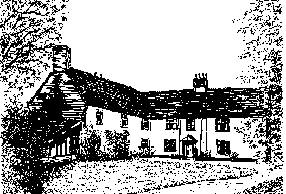
An ‘L’ shaped building with a tiled roof and looks to be a typical farmhouse.
This house retains part of a 15th century building but as it is freehold and there are no very early deeds, it is not possible to trace the first occupants.
By 1581 Richard Rampley, a yeoman, held it with 3 acres of arable land. His son Thomas would have been responsible for rebuilding the main part of the house in the early 17th century.
From c.1662 John Salkeld, a Presbyterian minister who was expelled from his living at Worlington for his outspoken religious beliefs, lived here. He was twice imprisoned for his views but was allowed to hold services at his home. His inventory of 1699 lists: a hall, parlour, kitchen, best buttery, small buttery, dairy, brew-house, hall chamber, parlour chamber, kitchen chamber, dairy chamber, maid’s chamber, vanser, malt chamber, cheese chamber, stable and cart-house. He owned fourteen leather chairs and books valued at £30.
26. Cranmer Farmhouse
Another free tenement probably dating from the 16th century (but not surveyed recently) with a jettied front, held by John Hawes of Cranmer, a yeoman (the house was on the edge of Cranmer Green). His widow married Francis Rookwood, a gentleman who was the second wealthiest man in Walsham in 1568. A deed of partition of land in 1643 called the tenement Cranmers or Rookwoods and declared it contained 62 acres of land.
27. Sunnyside
This house was built by John Robwood about 1520 and was held by a succession of John Robwoods who lived at the Beeches (54) but had lots of land at this, the east end of the parish. When the fifth and last John Robwood died in 1599 he left the house to his wife Dorothy; it was then in the occupation of Henry Osborne.
In 1844 the barn, stable, shed and pigsty of the then owner Richard Gapp, who was an overseer of the poor, were set alight by Robert Dew, a local man, who was transported for life.
28. High Hall
This is the moated site of one of the three medieval manors; the present house was built c. 1580. Surviving records refer not only to the hall but also to a dovecote, granary, dairy, sheepcote etc. There were swans on the moat. Although a listed building, it is now in a state of extreme dilapidation.
Note: this property is at the end of a private lane and is not visible from the road.
29. Cranmer Lodge
This is the oldest house in Walsham. It retains a portion of the late 14th century frame amongst its 16th century alterations but, being a free tenement, it is difficult to trace its early history.
On his death in 1577 Thomas Hawes, a yeoman, left a wife Joan and four sons. She was to have her dwelling in the parlour and in the parlour chamber, a third of the fruit in the garden and access to the oven and well. Her son George was to bring her wood and faggots.
30. Green Farmhouse
The home of another Hawes family, this house belonged to Church House manor. Probably built by Robert Hawes c. 1560 it was inherited by his son Andrew who died in 1610. In his will he is described as a yeoman. He left the house, orchard, garden and land to his wife Alice on condition she kept their son Francis during her life. After her death their son Thomas was to have the house, garden, orchard, hemp-land and croft on condition that he paid Francis £6 pa. Perhaps Francis was handicapped.
31. Hartshall Farm
Although an earlier house was almost certainly built on or near this site, the present house was built in the early 18th century by John Amys. The name Hartshall has nothing to do with a hall or deer but is a corruption of Hordeshawe, a field name.
Note: this property is along a private lane.
32. Fir Tree Farm
Built about 1600 this house replaced an earlier one on the site known as Brays or Tiptots after early tenants Robert Bray and Elias Tiptot. The Tiptot family continued to live there during the 15th century. In 1524 the tenant was Robert Jordan who was a yeoman, farming the 38 acres belonging to the tenement. When he died in 1546 he left his widow Katherine ‘wheat and malt sufficient for her bread and ale, wood, hay and a horse to ride to market at all times’. When she died she listed numerous household items in her will including a cheese press, salting trough, hive of bees, malt querns, milk tub, mustard querns, spinning wheel and a reel. In 1625 her grandson Robert paid tithes on four cows, a bullock, an orchard, geese and ‘four yongeons’.
33. Riding Farm
Built at the same time as Fir Tree Farm (this was a good time to be a farmer and many Walsham houses were rebuilt then). The earlier house on the site was called Qualms after Walter Qualm, probably the first tenant. The tenement comprised the messuage and 18 acres, including a narrow field leading up to the mill and ‘a parcel of land called Mill Mount with the ditches belonging to it’. This is where East Mill, one of two medieval post-mills stood.
34. The Quilett
Quilett means a medieval strip of land – very appropriate. It was built about 1520 by William Rampley. His son John died in 1584 leaving the house to his son John except for the parlour and the chamber over the buttery which his wife Katherine was to have for herself ‘and also for any of her friends at her or their pleasures’.
35. Crownland Farm
This is a late 16th century farmhouse built on the site of an earlier one called Ermitts or Carmans after 15th and 16th century tenants. It was originally a tenement containing 38 acres. Richard Cook, a yeoman, built the present house. His great grandson Thomas Cook was a member of the Separatist Brethren ie: a dissenter from the Church of England. Being denied burial in the churchyard, he was buried in his own orchard along with Anne Burrow ‘wife of John, put in a hole in Thomas Cookes yard 17th January 1653’ and Joseph Witting ‘singleman died at Upstrete and was put in a hole in Thomas Cookes orchard on the next day by the Brethren of the Separation’ died 15th November 1656. This information is in the Parish Register.
36. Crownland Hall
Crownland Hall stands on a moated site. The earliest mention of this freehold tenement was in the 1529 will of Hugh Lacy when he left 40 marks (a mark was worth 13s 4d) to buy a cross of silver and gilt for the church. In a Lay Subsidy of 1568, Thomas his son was the richest taxpayer in the parish. His son Thomas, along with Alice his wife, appeared before Norwich Church Court for refusing to receive communion but when he died in 1613 he asked to be buried within the church ‘near to the seat where I usually sit’ His nephew Thomas Lacy probably built the present house about 1620. In his will of 1686 Samuel Canham left his son Samuel his capital messuage in Upstrete called Crowland and his son William the goods in his butchers shop. During the Second World War the house was used as a school.
37. Crownlands
This cottage was not surveyed recently but is said to be early 18th century.
38. The Rosary
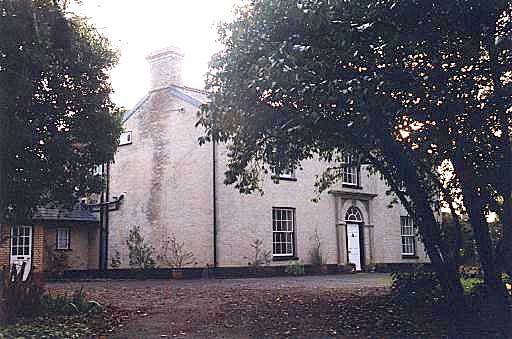
This house is not what it seems from the outside. Inside is part of the frame built in the early or mid 16th century by William Page, a yeoman. It was sometimes called Pages and sometimes Pakes, after Robert Pakke, the tenant of an earlier house on the site.
It remained with the Page family until 1644. In 1670 Robert Goulston, a wool-comber who had previously lived at 2, Vine Cottages (20) died. His inventory includes, in the wool chamber, wool valued at £165 and combed wool and yarn worth £12.
There was also a shop, probably a workshop. At the beginning of the 19th century Reverend Arthur Rogers ran a school here.
39. Four Ash Cottage
Said to be 17th century with older fragments this house has not been surveyed recently. It was originally known as Tussies after the first occupant of the site, Richard Tussy, when the tenement contained 18 acres.
The next tenant was Thomas Potenger who acted as hayward, reeve, woodward and ale-taster at different times during his lifetime. These were all essential posts that were carried out on the manor.
By 1527 the tenant was John Pope; he was fined 8d for failing to ring and tether his pigs. In 1577 it was held by his son William who also held Four Ashes Farmhouse (40). In 1611 it was said to be newly built but was destroyed by fire. A new house has been built on the same site.
40. Four Ashes Farmhouse
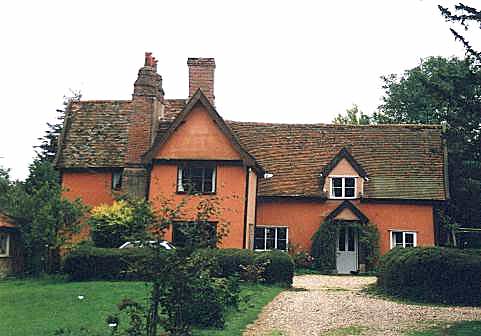
This is a late 15th century house. William Fuller built it when the lord of Church House manor granted him a close called Sheepcote Croft containing 4¾ acres with permission to build a house there. He surrendered it to his son John who failed to appear in court causing it to be seized by the lord and granted instead to William Baker.
Two of the first entries in the Parish Register in 1545 are those of the burials of Agnes and Alice Brownsmith, servants of William Baker. When he died in 1557 he left money to Henry Brownsmith, his wife’s brother, so Agnes and Alice were his nieces.
The 1577 survey states that William Pope held the tenement ‘very well builded’. In 1607 he surrendered it to George Complyn, a gentleman who lived at the Beeches (54). When he died, his eldest son had the Beeches and William, his second son, Four Ashes Farmhouse. William went on to become the High Constable of the Blackbourne Hundred.
41. Thatched Cottage / Thumbit
The Thumbit is the parlour end of a house built c.1580. It was first held by William Pope, said to be ‘newly built’ in 1581. Its tenants through the years are the same as for Four Ashes Farmhouse; it probably housed workers on the farm. For a short period in the 18th century it was The Chequers – a public house.
42. The Elms
This is an 18th century house built on the site of a medieval house with 18 acres of land known as Spicers. In 1817 the present house was owned by Rev. Arthur Rogers and occupied by Samuel Golding who went on to build the Grove (55). In the 20th century it was the home of Mr and Mrs Bennett whose son Captain Harold Bennett died in November 1914, at the beginning of the First World War.
43. The Garden House
There is a fragment, the remains of a mullion window, of the original 15th century house preserved within this cottage. The timber frame was not intended to be seen and was originally plastered over. It was once the home of John Pepper and later Thomas Murrell, both of whom served as woodward on the manor and was called Peppers or Murrells. It was later held by Robert Jordan, a yeoman, who lived at Fir Tree Farm; the wealthier farmers often had a second property which they rented out and then left to the second son. In 1654 Thomas Rainbird was granted a licence to demolish part of the house and an outhouse and to rebuild. The later part of the house dates from this period.
44. South Cottage
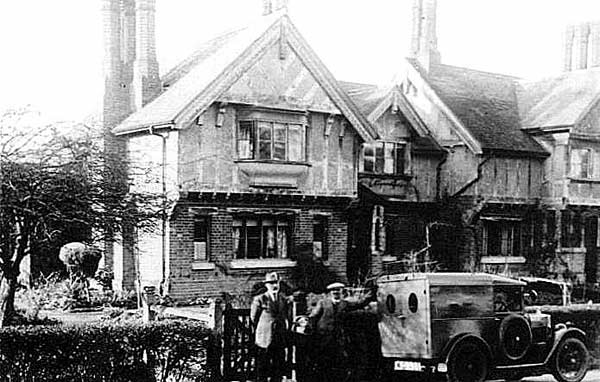
These mock Jacobean estate cottages were built by John Martineau ‘long before it became the popular cry that the fundamental basis for improving the health, happiness and morals of England was decent and healthy housing’. Each dwelling had ½ acre of garden, a pigsty, a walnut and an apple tree, a shared bake-house, washhouse and well with a pump. There was also a spare room known as a ‘widow’s room’.
45. Church Rise Cottage
This is an 18th century cottage built on the site of an earlier one called Girlings or Bretts after Edward Girling and Thomas Brett, two early tenants. It contained just 1 acre of land and was later held by Nicholas Martin of Church Farm.
46. Church Farm
Known as Hoxons this house was built by William Hoxon in 1534 with a workshop and a 2 acre croft. It was then surrendered to Walter Martin, a blacksmith. It remained in the Martin family until at least 1695. It had a new parlour built on the north end of the house to which Nicholas and his wife Alice were to have liberty when they surrendered the property to their son in 1601. Walton Kent, a surgeon lived here in 1844.
47. Church View
This brick double-dweller was the first of several estate cottages built by John Martineau to provide accommodation for his workers and their families. It cost £358 10s 4d in 1866. Notice the hitching ring for horses on the flint wall to the left of the gate
48. Sweetbriars
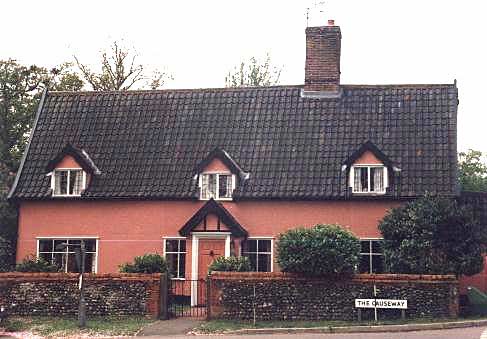
Probably built about 1495 by Thomas Fynn after he had allowed the earlier house to fall into disrepair. One of the occupants of the earlier house was John Beacon, giving it the name of Beacons. It was built as an open hall and had a shop at the north end; a butchers at one time when Thomas Vincent lived there.
It was remodelled in the 16th century when the ceiling was inserted. The lintel over the fireplace has a carving of a Tau cross, the arms of the Drury family, although they were not a local family. Perhaps the lintel is reused timber. In 1679 Thomas Roper was given a licence to enclose part of Hall Green, on which the cottage stood, with a fence or wall – making the garden.
49. St. Mary’s Church
The parish church was built in the early 15th century replacing a Norman one, which probably replaced a wooden Saxon one. Full information on this historic building can be found inside the church and on the St. Mary’s page on this website.
50. Priory Room
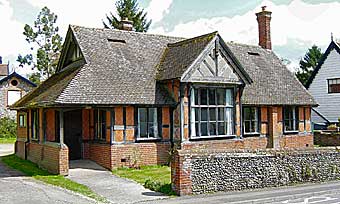
Another typical Martineau building which is a Meeting Room, not a residential home.
The photograph is taken from in front of thesingle storey building and shows the very large window almost in the centre of the front face. The entrance porch is at the left of this front face and there is the usual beams that are part of the character of these buildings.
The Priory Room was built in 1902 for use as a Sunday School. The 1817 map shows a barn on this site – the Priory barn of the rectory.
51. Prior’s Close
Although there was an earlier house on this site, the present house was said to be ‘newly built’ in 1606 when it was held by John Page who lived at the Rosary (38). One of its earlier tenants was Alice Vincent, a widow, of whom it was said ‘she is a common whore and unclean of body to the great peril of the lord’s tenants and harm to the youth within the village’. Grove Road, the next on the left, was known as Whoretouts Lane. Occupiers of the present house, though, were quite respectable and included relations of Samuel Golding the solicitor.
52. Bridge Cottage
A fragment of the mid 17th century frame remains in this cottage but there are no early records of its tenants. In 1817 it was owned by John Carter and occupied by Ham Steward.
53. The Priory
The central part of this building is dated at 1520-1560 and the extensions at either end are Victorian. Known as the Parsonage House or seat of the manor of Church House, this, presumably is where the Church House manor courts were held before the Reformation. In the early 19th century it became the vicarage and remained so, until quite recently, when the new rectory was built in the Causeway.
54. The Beeches
In 1458 John and Joan Robwood acquired a ½ acre plot next to the Priory belonging to Church House manor and built the first phase of the Beeches. The Robwood family had lived in Walsham for at least two centuries, surviving the Black Death and prospering by obtaining more houses, land and a sheepfold. It was a later John Robwood living at the Beeches who first added ‘in the Willows’ to the Walsham place name in his will of 1537. By 1577 his son John was the largest landholder in the parish, with 186 acres including at least 50 acres of pasture.
The house was enlarged at the end of the 16th century. In 1617 George Complin, a wealthy yeoman, moved in and the house remained in that family for the rest of the 17th century. For the last 100 years it has been the home of the village doctor and, until 1993, a surgery was held there.
55. The Grove
This is a large early 19th century white brick house with a slate roof built by Samuel Golding, a local solicitor. It has a semi-circular bay with a domed roof.
56. Clipper Cottage
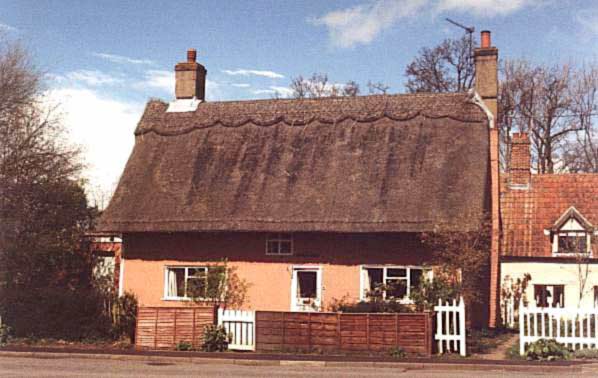
This cottage and the one to its rear were referred to as one tenement called Cooks and Coppelowes and it is not possible to distinguish one from the other in the records. It was built sometime between 1520 and 1580.
57. Gurnards/Jackdaw Cottage
Built as one cottage between 1450 and 1500, the first tenant was John Page. In 1487 it was surrendered to William and Alice Waller and a rental of 1595 states that William Waller paid for two tenements – Pages and Coppelowes. They remained in the Waller family until 1601. An inventory of Sylvester Howlett dated 1668 mentions only a hall and chamber with goods valued at just £8 7s 11d. The Rev. Arthur Rogers owned the property in 1817, described as cottages and gardens and occupied by four families.
58. Four Ashes House
There has been a house on this site since at least 1326 when William Kembald, chaplain was accused of wasting and damaging the tenement Kembalds. Other early tenants included John Frances, Robert Pepper, Richard Page, William Potenger, chaplain and William Page who lived at the Rosary (38). He was a yeoman, whose will in 1543 included money ‘ to carry out of my gravel pit three score loads of gravel to lay in the fowle wayes where they think best’’
The present house was probably built by Thomas Page, his son, also a yeoman at the end of the 16th century and it stayed in the Page family for another century. By 1817 it was part of three cottages owned by William Day, a carpenter and beer retailer and occupied by John Banks and others.
59. Grove Cottage
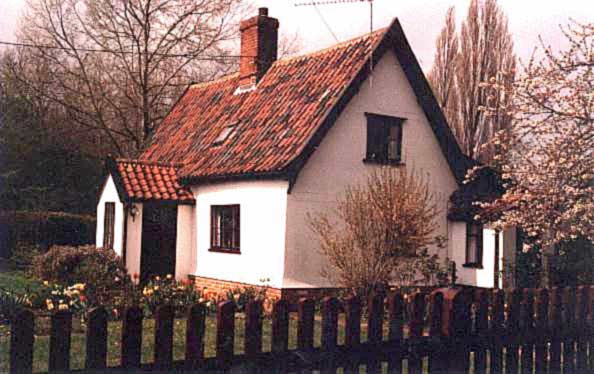
The earlier house on this site was called Vauncies after John Vauncey who had a messuage here in 1344. It changed hands fairly regularly until 1570 when Anthony Padnall became the tenant.
The Parish Register gives two instances of babies born there; ‘a nurst child out of Anthony Padnel’s house’ and ‘a strange child, her mother lay in Antony Padnals’. Was this an early maternity hospital?
The present house was converted from a non-domestic building using re-used timber and is therefore impossible to date. Its later tenants include John Grocer, a linen-weaver who died in 1676 leaving the house to Stephen Windout whose sister Hannah was to ‘have the parlour and parlour chamber for herself, her husband and company. Also access to the yard to fetch water from the pond, to hang linen and set wood and to have half the fruit from the new orchard on the east side of the house’. Samuel Youngman, a tailor was the tenant in 1695.
60. The Old Vicarage
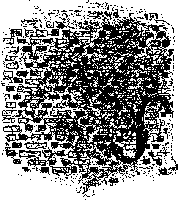
There was a house on this site by at least 1332 called Spilmans. The tenement contained 28 acres of land and wood and provided the reeve and hayward for the manor on a rota system. First John and then, Stephen Hawes held it from 1470 to 1596. William Page who was a tailor and a church warden was the next tenant and then his son Thomas who also held Four Ashes House (58).
It then changed hands quite often until 1696 when it was acquired by a yeoman named William Baker. In 1817 it belonged to William Cornell who owned nearby maltings. From 1869 till the turn of the century it was the home of the local vicar.
61. Willow Tree Farm
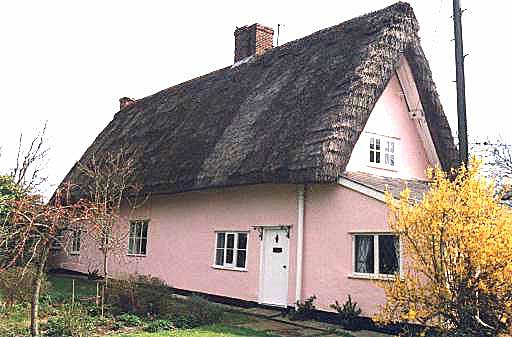
The first tenant of the earlier house on this site, from at least 1463, was William Fuller. In 1524 Thomas Robwood was told he would lose it forever if he failed to repair it: it belonged to Church House manor. In 1547 his widow Ann was ordered to repair the roof. These problems may have led to its rebuild c. 1580, probably by John Robwood, who, in 1562 had leased it to William Clarke, a butcher.
The next tenant was Arthur Seddon, a clerk, who in 1601 surrendered it to Barwick Bulmer, a gentleman. He may have had another house in Walsham because when he died in 1620 he ensured that his mother-in-law had ‘sufficient tabling, diet, meat and drink and a convenient chamber with free ingress to the mansion house in Walsham’.
62. The Pound
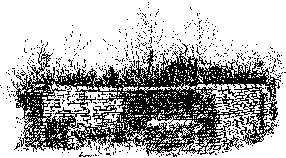
For stray animals was erected in 1819 when the last of the common land was enclosed.
63. Clay Cottage
This building is the only one left of a whole street of houses, in Clay Street, that bordered the southern side of Cranmer Green. Built about 1510 its first tenant was William Grimsby and therefore it became known as Grimsbies. John Grocer, a weaver was the next tenant. His will of 1551 includes access for his son John to ‘the going and standing to the tenters using the accustomed way’ and ‘two pair of looms, my working stays and my guyll wheels’. The tenters were frames for stretching woollen cloth. In 1605 John Jolly became the occupant: the nearby allotments are still called Jolly’s Allotments.
64. Town House
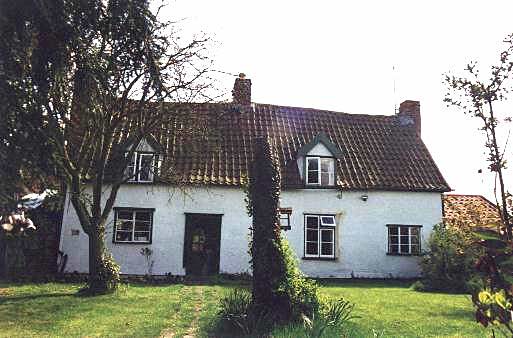
So called because it was acquired by the ‘town’ of Walsham to accommodate the poor, it was built probably in 1490 when William Fletcher and Elizabeth his wife acquired a close containing 1¾ acres of the tenement Nobles. This tenement supplied the collector of the rents of the manor, in 1523 Thomas Carter and in 1521 Thomas Frances were elected– someone had to do it.
By 1695 Richard Warner, a cordwainer (shoemaker) and regular jury member ie: a well thought of resident lived there. It was acquired by a Walsham charity some time between 1817 and 1842 and the 1844 Suffolk Directory states that it was occupied rent free by poor families. It served this purpose until 1933 when, in a dilapidated state it was sold for £80.
65. Fernside
This house was built c. 1520 by William Vincent, whose son William surrendered it, in 1571, to William Hawes. When his son Stephen died he left the house to his son James – his wife Jane was to have ‘her dwelling alone unto herself in my parlour with free ingress and egress as long as she remain unmarried’. James remained in the house until 1689 when he surrendered it to Thomas Bennett.
The tenement was always described as containing 1¼ acres, not large enough to support a family; the tenants would either have held other land or earned a living at some trade.
66. Cygnet House
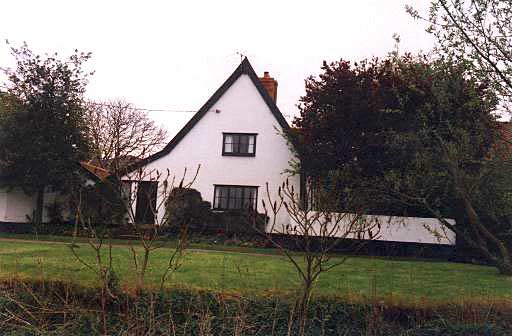
Built as a non-domestic building in the early 17th century the building was converted to a house soon after. There was a problem regarding access. William Rice held a barn and needed to take carts through Francis Wright’s garden and Francis had to go through the barn to repair his cottage. Perhaps the cottage was demolished and the barn became Cygnet House. The house is so named because it was once the Swan public house. A pork butchers shop adjoined the Swan. It was converted into a private house in 1952.
67. Bank House
So called because it contained an office of Lloyds bank around 1912. Its medieval name was Lakenhams after William Lakenham, who brewed ale in the 14th/15th century.
William Rice, a yeoman, became the occupier by 1573 and in his will of 1613 he left ‘yearly as long as the world endures 30s to the minister, churchwardens and overseers of Walsham to buy some Welche [Welsh] cloth for the clothing of some poor old folks of Walsham’. Later town wardens’ accounts show money spent on ‘town gowns’.
68. Riverside
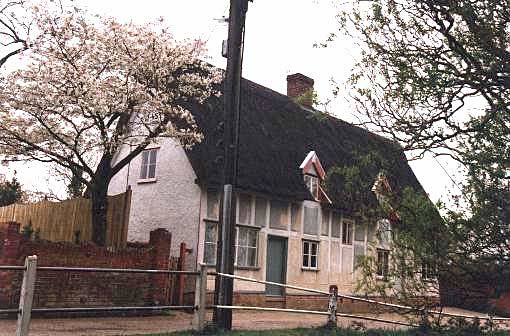
Although 1745 is written in the apex of the gable this cottage was built sometime between 1630 and 1680. From 1569 onwards documents refer to it, as Ballards so there was an earlier house on the site.
In 1813 Isaac and Catherine Pamment lived here. They had ten children, the seventh of whom, Zachariah, was transported to Australia for seven years for stealing glass (he was a glazier). Zachariah left a wife and baby daughter in Walsham. His wife died young and the baby was brought up here by her grandparents. Zachariah never returned. He remarried in Australia and went on to have another family.
69. National School
The small white brick building by the stream was part of the school started in 1848 to conform to the Education Act. The cottage next door was the school house and has a side door that led to the playground.
70. Avenue Cottage
The front part of this cottage was built between 1550 and 1600; the other part is a 17th century extension. Part of the house seems to have been lost when the Avenue (a coach road for the Grove (55) was made in the early 19th century. Known as Leves or Randes there has been a house on this site since at least 1410. Edmund Leve was the first tenant on the site; Adam Rande was probably the first tenant of the present house. The tenement contained 3½ acres of land, a small peasant holding.
71. Avenue House
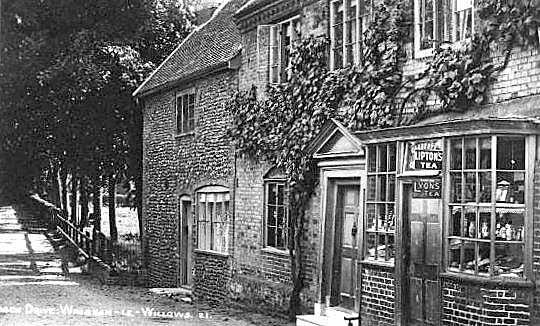
An 18th century house, with an adjoining cottage that was one of five houses held by John Grocer who lived at the Rosary (38). Edward Colson, a boot and shoemaker lived in the house in 1844. Frederick Colson occupied it from 1855 to 1896, following varied trades including beer retailer, farmer, shoemaker, flour dealer, victualler and tax collector. From 1900 onwards it became a coffee tavern known as the Golden Lion.
72. The Old Bakehouse
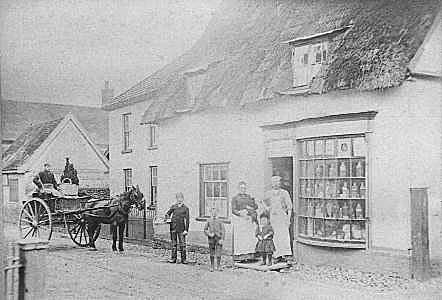
This is a late 17th century house with a crown post from an earlier building re-used in the front room downstairs. Henry Block, a yeoman whose inventory in 1679 included a shop containing butchers axes, cleavers and scales. During the 19th century it was owned by William Darby, a baker who also owned the mill in Wattisfield Road and then by Henry Drake a plumber and glazier. Early in the 20th century it was acquired by William Kenny and became the village bakery.
73. Clive House
A 17th century house, whose earliest tenants included William Hawes, a victualler and Thomas Collyer a worsted weaver. During the 19th century it was owned by William Darby and Henry Drake together with the Old Bakehouse. By 1876 it belonged to John Proctor, a stone mason whose work can be found in the churchyard. In 1882 it was acquired by James Aldridge, a tailor and outfitter who probably added the extension at the west side to provide extra light while he was working.
74. Clive Cottage
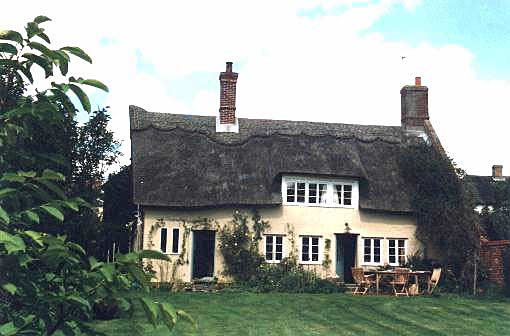
This cottage was built about 1500 and is difficult to identify amongst early documents. In 1537 Thomas Lacy, who lived at Crownland Hall (36) acquired a ‘cottage, namely a house called a bakehouse…’ on this site, but Clive Cottage is a domestic building. His son Thomas surrendered it to George Complyn from the Beeches (54) who surrendered it to Gregory Orvis. His son John was admitted in 1654. He died in 1656 and the entry in the Parish Register reads ‘died at Stanton Cock, a very sad example for all pot companions’.
Its later owners are the same as for Clive House but the cottage, which previously extended further east, had numerous tenants, often three families at any one time.
75. The Village Rooms
The Village Rooms were built as a public hall, erected in 1858 for use as a Reading Room and Library. Lectures, recitals etc. were held here at a time when entertainment was largely home made.
76. The Blue Boar
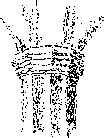
This building is not what it appears from a quick glance. Go inside and find the evidence of the service doors and screen from the original open hall of c.1420. There is a crown post in the roof space.
The first occupant was Alice Pye, an ale-wife (she brewed and sold ale). In 1447 it was granted to John and Alice Bay and became known as Pyes or Bayes. It belonged to Church House manor and John Bay was a member of the court jury as were later tenants of the house; being a large house in a prominent spot it attracted prominent tenants.
During much of the 17th century it was the home of Reginald Page who was bailiff of the manor and a churchwarden. His wife was paid by the town wardens to teach a local child.
Cottages built at the front of the house were first used as shops; they were demolished within living memory. Thomas Youngman, a tailor was the occupant from 1693. By 1817 at least it was a public house called the Boar where local auctions were held.
77. St. Catherines
Built in the 17th or 18th century, an earlier house and shop on the site was held by the Clarke family who also held the White House (15). Richard Warner, the cordwainer who lived at Town house (64) also held the house and shop. He may have built the present house.
78. Beacons
This cottage has ‘stolen’ the name from Sweetbriars (48). It is not mentioned in early documents and may have been considered part of Sweetbriars. It has part of a late 16th century frame preserved. In 1817 it was used as an office for a small maltings next door.
79. The Lawn
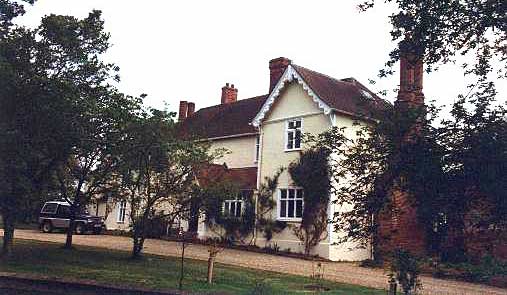
Built between 1620 and 1660 with later additions, this house has been home to the Martineau family for many years. As a free tenement it is difficult to trace early occupants of a previous house on the site but Thomas Flatman, a gentleman who married Elizabeth Hawes appears to have acquired the house when her parents Richard and Elena died in 1574. The Flatmans lived at Starston in Norfolk and gradually disposed of their Walsham property.
John Page another gentleman acquired the house in 1612 and was responsible for building the present house. His will of 1688 included a capital messuage and a close called Couldham Park. S o he may have been the one who laid out the parkland which surrounded the Lawn. He also had a messuage and a shop in Bury.
80. A Nameless House
Owned by Mr. and Mrs. Cobbold – why not call it Wardes its medieval name? Wardes tenement was first mentioned in 1393 when a lock was broken on the gate. In 1469 Elizabeth Warde, widow of Robert, surrendered an earlier house on this site to Robert Baker but kept the ‘chimney chamber, hemp yard, pasture for her cow, a pig, firewood for life, half the apples, pears, nuts and filberts and all the osiers in the garden’ (which backed onto the flood plain).
The present house was built some time between the mid 16th and mid 17th century by a later member of the Baker family, either Richard or Thomas. A later Robert Baker died in 1667; his inventory included a hall, bedchamber, buttery, cheese chamber, dairy and back house but no parlour. The parlour had disappeared and is still missing!
81. Home Farm
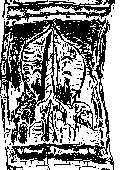
Built between 1510 and 1540 with a new parlour of 1580-1610, this was a free tenement by the name of Margerys, the early tenants being Robert and John Margery. It was probably built by John Hawes of West Street (to distinguish him from several other John Hawes) who died in 1528 leaving amber beads to his wife Katherine.
The two service doors remain intact. In 1609 it was acquired by William Hawes, a gentleman who was Town Clerk of Ipswich. He probably built the new parlour, which has some fine leaf carvings.
